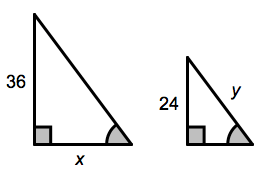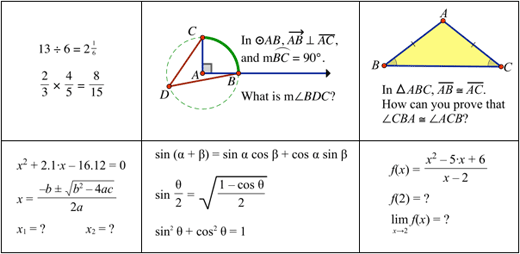
 
 |
Using Sketchpad as a Productivity ToolSketchpad is a powerful mathematical and classroom productivity tool for creating documents and presentations. You can generate precise, high-quality mathematical graphics that you can cut and paste into most computer programs. In fact, you can even use Sketchpad to compose graphics for professional articles, journals, and books. Sketchpad’s graphical capabilities also make it ideal for multi-page presentations with animations, Hide/Show buttons, and accompanying text. Include figures and graphs in worksheets, quizzes, and tests.
Create publication-quality illustrations.You can use Sketchpad to create high-quality illustrations for use in publications. Begin by using Sketchpad’s point and line styles to fine tune the appearance of your sketch, using mathematical italicization and formatting, and fine-tuning the colors and positions of objects in your sketch. When everything looks just the way you want it to appear in your publication, export your illustration either to the clipboard or to a new graphics document. In Windows, you can copy your construction or mathematical text to put it on the clipboard in EMF (Enhanced Metafile) format, or you can save the entire sketch as an EMF document. On Macintosh, you can copy your construction or mathematical text to put it on the clipboard as a PDF, and you can use Preview to save the clipboard contents as a PDF document. In either case, you can use Adobe Illustrator or another publication-quality graphics program to edit the resulting document or convert it to a different graphics format such as EPS. The result of this process is a publication-quality illustration that prints in high resolution and can be scaled without loss of quality. Create richly formatted mathematical text.You can include fractions, overbars, exponents, square roots, angle, triangle and degree symbols, and much more in your presentations and graphics with Sketchpad’s Text Palette. Many teachers create all their worksheets, quizzes, and tests in Sketchpad and print them directly from Sketchpad because they find Sketchpad easier to use than their word processor. Some even use Sketchpad to create worksheets you might not associate with Sketchpad, such as a page of fraction addition problems. Use Sketchpad’s Text tool to create richly formatted mathematical text. When you create a caption, the Text Palette appears (if not, choose Display | Show Text Palette). Click the rightmost button to show the bottom row of formatting options.
Below are some examples of the output you can create. For more detailed information about formatting mathematical text, read about the Text Palette in the Reference Center.
Create classroom presentations.Sketchpad is a multimedia tool that changes the nature of classroom presentations. Use Sketchpad as your mathematical presentation program by creating a sketch with multiple pages. Add action buttons and Hide/Show buttons to each page to create dynamic presentations that add excitement and mathematical interest to your lessons. Use the Marker tool to annotate constructions and draw attention to the important mathematics as you talk to your students. Use Hot TextTM to link the mathematical notation in your captions to the objects in your construction. If you use Sketchpad to create a presentation that you want to use again and again, consider making the document read-only so you don’t inadvertently save it after you have made changes during a live presentation. You may want to create a “reset” button to return objects in your sketch to their initial state, particularly if the sketch includes an animation that you want to show students multiple times. A Sketchpad “reset” button is usually a Presentation button that combines Movement and Hide/Show buttons. Sketchpad’s unlimited Undo lets you go back and repeat any portion of a Sketchpad presentation. Combined with an interactive whiteboard, Sketchpad is the ideal mathematics presentation tool. Read More tips for using Sketchpad with interactive whiteboards. If you have a computer projector but no interactive whiteboard, project Sketchpad onto a standard whiteboard and combine the projected image of Sketchpad with hand-drawn images on the board. For instance, ask a student to draw a given function on the whiteboard, using the axes projected in a Sketchpad sketch. When the student has finished, click a Hide/Show button in the sketch to reveal the actual graph of the function so students can see whether the hand-draw function matches the Sketchpad graph. Similar interactivity between student hand-drawn images on a whiteboard and those projected by Sketchpad can make “working at the board” more meaningful and fun. If you do not have a computer projector, you can print a Sketchpad model on a transparency for use with an overhead projector, or paste Sketchpad images into Microsoft PowerPoint or another presentation program. Export dynamic mathematics to the Web.Once you’ve created a presentation sketch, you or your students can turn the result into a Java applet that you can embed into a web page. Visitors to your web page can then manipulate the applet by dragging points and pressing action buttons. For an in-depth discussion on saving your sketch as a Java applet, read about JavaSketchpad in the Reference Center. Produce different types of graph paper.You can use the Graph menu to create square, rectangular, or polar axes, with axes labeled in units of π if you like. Choose Help | Sample Sketches & Tools to find semi-log and log-log graphs, and several varieties of geoboards. Use these graphs and geoboards for Sketchpad investigations, paste them into other documents, or print them directly from Sketchpad.
|
 Sketchpad works well with Microsoft Word and other word processing programs. With Sketchpad as your graphics program, your classroom handouts can look as good as any textbook. First, construct the objects you want in Sketchpad. Then, select and copy them, and paste them into your word processor or other program. You can modify your Sketchpad figures to include before-and-after images or a longer sequence of images in a process. Drag points and change parameters in your sketch to put five similar problems into a worksheet, or to create multiple forms of a test. Sketchpad gives you easy control over your graphic output. Lines and rays—which appear onscreen as if they extend forever—appear with arrowheads in exported graphics. To change this setting, hold the Shift key and choose Edit | Advanced Preferences, and then use the Export panel.
Sketchpad works well with Microsoft Word and other word processing programs. With Sketchpad as your graphics program, your classroom handouts can look as good as any textbook. First, construct the objects you want in Sketchpad. Then, select and copy them, and paste them into your word processor or other program. You can modify your Sketchpad figures to include before-and-after images or a longer sequence of images in a process. Drag points and change parameters in your sketch to put five similar problems into a worksheet, or to create multiple forms of a test. Sketchpad gives you easy control over your graphic output. Lines and rays—which appear onscreen as if they extend forever—appear with arrowheads in exported graphics. To change this setting, hold the Shift key and choose Edit | Advanced Preferences, and then use the Export panel.

